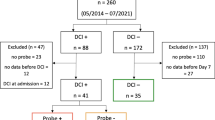Abstract
The use of endovascular intervention to treat cerebral vasospasm after subarachnoid hemorrhage has increased. Although the effect on angiographic vasospasm can be easily demonstrated, the effect on cerebral blood flow and clinical outcome is still controversial. In this report, we investigate minute-by-minute changes in brain tissue oxygen during balloon angioplasty and intraarterial administration of vasodilators in three patients.
Our results confirm that endovascular intervention is capable of not only resolving angiographic vasospasm, but also of normalizing values of brain tissue oxygen pressure (PtiO2) in target parenchyma. However, during the intervention, dangerously low levels of brain tissue oxygen, leading to cerebral infarction, may occur. Thus, no clinical improvement was seen in two of the patients and a dramatic worsening was observed in the third patient. Because the decrease in brain tissue oxygen was seen after administration of vasopressor agents, this may be a contributing factor.
Access this chapter
Tax calculation will be finalised at checkout
Purchases are for personal use only
Similar content being viewed by others
References
Al-Tamimi YZ, Orsi NM, Quinn AC, Homer-Vanniasinkam S, Ross SA (2010) A review of delayed ischemic neurologic deficit following aneurysmal subarachnoid hemorrhage: historical overview, current treatment, and pathophysiology. World Neurosurg 73:654–667
Deshaies EM, Jacobsen W, Singla A, Li F, Gorji R (2012) Brain tissue oxygen monitoring to assess reperfusion after intra-arterial treatment of aneurysmal subarachnoid hemorrhage-induced cerebral vasospasm: a retrospective study. AJNR Am J Neuroradiol 33:1411–1415
Dorsch NW (1995) Cerebral arterial spasm – a clinical review. Br J Neurosurg 9:403–412
Hoelper BM, Hofmann E, Sporleder R, Soldner F, Behr R (2003) Transluminal balloon angioplasty improves brain tissue oxygenation and metabolism in severe vasospasm after aneurysmal subarachnoid hemorrhage: case report. Neurosurgery 52:970–974
Jaeger M, Soehle M, Schuhmann MU, Winkler D, Meixensberger J (2005) Correlation of continuously monitored regional cerebral blood flow and brain tissue oxygen. Acta Neurochir (Wien) 147:51–56
Keyrouz SG, Diringer MN (2007) Clinical review: prevention and therapy of vasospasm in subarachnoid hemorrhage. Crit Care 11:220
Stiefel MF, Spiotta AM, Udoetuk JD, Maloney-Wilensky E, Weigele JB, Hurst RW, LeRoux PD (2006) Intra-arterial papaverine used to treat cerebral vasospasm reduces brain oxygen. Neurocrit Care 4:113–118
Vergouwen MD, Vermeulen M, van Gijn J, Rinkel GJ, Wijdicks EF, Muizelaar JP, Mendelow AD, Juvela S, Yonas H, Terbrugge KG, Macdonald RL, Diringer MN, Broderick JP, Dreier JP, Roos YB (2010) Definition of delayed cerebral ischemia after aneurysmal subarachnoid hemorrhage as an outcome event in clinical trials and observational studies: proposal of a multidisciplinary research group. Stroke 41:2391–2395
Conflict of Interest Statement
We declare that we have no conflict of interest.
Author information
Authors and Affiliations
Corresponding author
Editor information
Editors and Affiliations
Rights and permissions
Copyright information
© 2015 Springer International Publishing Switzerland
About this chapter
Cite this chapter
Rasmussen, R., Bache, S., Stavngaard, T., Skjøth-Rasmussen, J., Romner, B. (2015). Real-Time Changes in Brain Tissue Oxygen During Endovascular Treatment of Cerebral Vasospasm. In: Fandino, J., Marbacher, S., Fathi, AR., Muroi, C., Keller, E. (eds) Neurovascular Events After Subarachnoid Hemorrhage. Acta Neurochirurgica Supplement, vol 120. Springer, Cham. https://doi.org/10.1007/978-3-319-04981-6_31
Download citation
DOI: https://doi.org/10.1007/978-3-319-04981-6_31
Published:
Publisher Name: Springer, Cham
Print ISBN: 978-3-319-04980-9
Online ISBN: 978-3-319-04981-6
eBook Packages: MedicineMedicine (R0)




